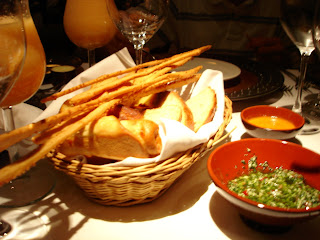 Alfresco
AlfrescoMalecon Balco 790
Miraflores, Lima
$10 or so per person for lunch
One of the restaurants that came up time and again on the Peru Chowhound boards was Alfresco for ceviche. Along with Puerto Madero, Pescadores Capitales and La Mar, Alfresco was on my list of possible lunch places. My plan was just to accumulate a selection of restaurants I know with a good reputation so that I could stumble into any one of them when a meal came up. However, when our driver picked us up at the airport, he immediately suggested Alfresco. So off we went!

The interior of the restaurant is casual, with a beach theme. The Northern wall has a large mural of coastal scene, and the large windows make the place bright and airy, even if Lima is never sunny in the Winter. From my research, I've heard that ceviche is only eaten at lunch and that Alfresco only served lunch, but when I arrived, I found an advertisement for their extensive dinner menu as well. I glanced at the menu, but I already knew what I came here for.
Ceviche, or sometimes cebiche, is something of a coastal delicacy popular in Lima. It's relatively common not only in Peruvian cusine, but also in any number of Latin American countries with access to fresh seafood. Ideally, it's a simple preparation of any type of white fish marinated in lime juice with some other flavorants such as red onions and chiles. You may have commonly heard that ceviche is raw, but the acid in the juice actually denatures the proteins of the seafood, in a form of heatless cooking. While it's debatable whether or not cooking has to involve heat, it's not debatable that Peru is home to some excellent ceviche. Due to the Japanese influence, Lima also has tiradito, which is a younger brother to the ceviche, lacking onions and less of a strong flavor more akin to Italian crudo.

To start, the waiter brought out a small bowl for the table. At first I was startled by its appearance, looking somewhat like little bugs. I know insects aren't completely foreign from the table in certain South American countries, as mentioned in my post about entomophagy, but I hadn't heard of any instances of it in Peru. Luckily, I realized that this was a bowl of cancha instead, roasted corn kernels. These make a terrific bar food and went well with my beer. I could definitely snack on these as an alternative to nuts or pretzels at the bar.

Again, a charge for bread meant the rolls that arrived were delicious. The larger ones were nothing particular, but the small rolls along the edge of the plate are onion rolls no larger than a half-dollar in circumference. I popped one into my mouth and got a surprise of rich onion paste filling. I always wonder how much more I eat when the portions are small enough to fit several into my mouth at once.

Finally our ceviche came. Since I didn't quite know what the portions were like and I wanted to try a combination, I ordered two different types of sampler platters for the four of us. The first plate in the top picture consisted of mixed ceviche, tiradito with lemon chili cream, causa (potato cake), octopus with olive sauce, a California roll and seafood salad. I don't even pretend to know which item is which, so you might have to use your detective work to figure it out. Although I do know the one on the bottom left is the ceviche.

The second plate consisted of flounder ceviche, tiradito in lemon pepper vinaigrette, crayfish cocktail, scallop tartare, octopus salad, salmon nigri and something call an Inka maki. In both plates, the plainest ceviche was always the best. The octopus is also surprisingly tender, lacking the chewiness common when served raw. I loved the presentation of each individual dish on scallop shells. It was quite a bit of food as just an appetizer for four people though.

With two appetizer, we decided to order three entree for the four of us. My scallops were disappointing. I wasn't sure how it would be prepared, but I didn't like the heavy sauce, which reminded me of the sauce served on takoyaki in Japan. I was also less than thrilled with the plating after they've already served the scallop shells with the ceviche. Although, it was nice to know they were using whole scallops.

My mom and dad shared a pretty grilled octopus salad. I actually don't remember much about how this tasted and there's nothing in my notes, so I suppose it wasn't particularly memorable.

As much as the other two entrees were letdowns, my brothers squid ink risotto was the redemption. I'll agree, it's not particularly appetizing to eat something that looks like that, but I wonder if there's anything really delicious that's black. The ink was fresh, so it didn't have a fishy taste. However, the waiter told us there was no calamari, so they were substituting it with crab, crayfish and shrimp instead. Makes you wonder what happened to the pens in the restaurant.
At this point we were all stuffed to the gills. Fresh seafood is usually pretty hard to screw up as long as the cooking process is kept simple and quick. I had my taste of the sea, now it was time to move inland.

































